 Research Article
Research Article
Review on the Production and Marketing of Banana in Ethiopia
Zinabu Ambisa*, Bikila Tesfa, Temsgen Olani and Diriba Abdeta
Department of Agricultural Economics , Bedelle college of Agriculture and forestry, Ethiopia
Zinabu Ambisa, Department of Agricultural economics, Mettu University, Bedelle college of Agriculture and forestry, Ethiopia.
Received Date: March 25, 2019; Published Date: April 22, 2019
Abstract
The review was mainly focused on to review the production and marketing of banana in Ethiopia. Specifically aims to review the overall status of banana production, banana marketing and its constraints in the Ethiopia. Dessert banana and plantain (Musa sp.) are the fourth most important staple food crops in the world after rice, wheat and maize. Currently banana in Ethiopia covers about 59.64% (53,956.13 hectares) of the total fruit area, about 68% (478,251.04 ton) of the total fruit produced, and about 38.3% (2,574.035) of the total fruit producing farmers. On the other hand, about 68.72% (37,076.83 hectares) of land covered by banana, about 77.52% (370,784.17 ton) of the banana production, and 22.38% (1,504,207) of the banana producers in Ethiopia are found in the Southern Nations Nationalities and Peoples Regional State (SNNPRS). Hence as we have reviewed several researches conducted by several authors are concentrated in the southwestern part of the country in the Southern Nations, Nationalities and Peoples Regional State (SNNP) and Oromia Regional States this is due to the authors select this area purposively depending on productions potential. So that it’s better if researches are conducted on other part of the country. And also, several researches are conducted on banana marketing but not on production, again its better if researcher include its production in their thesis.
Keywords: Banana; Constraint; Marketing; Production
Introduction
Background and justification
Dessert banana and plantain (Musa sp.) are the fourth most important staple food crops in the world after rice, wheat and maize [1]. Dessert banana in particular is a commercially important crop in the global trade, both by volume and value, as a leading fruit [1].
In 2010, world commerce in banana was valued at US 8.05 billion and the total world production of banana is about 106,541,709.00 tons [FAOSTAT, 2012]. For many African, Asian and Latin American countries, banana is as well one of the most important fruit for foreign exchange earnings [FAOSTAT, 2012].
Dessert banana is also the major fruit crop that is most widely grown and consumed in Ethiopia. It is cultivated in several parts where the growing conditions are favorable. Especially in the south and southwestern parts of the country, it is of great socioeconomic importance contributing significantly to the overall wellbeing of the rural communities including food security, income generation and job creation [2].
Currently banana in Ethiopia covers about 59.64% (53,956.13 hectares) of the total fruit area, about 68% (478,251.04 ton) of the total fruit produced, and about 38.3% (2,574.035) of the total fruit producing farmers. On the other hand, about 68.72% (37,076.83 hectares) of land covered by banana, about 77.52% (370,784.17 ton) of the banana production, and 22.38% (1,504,207) of the banana producers in Ethiopia are found in the Southern Nations Nationalities and Peoples Regional State (SNNPRS) [25].
Gamo Gofa, Bench Maji, and Sheka zones are among the major banana producing zones of the SNNPRS [3].
Objectives of the review
General objective:
• To review the production and marketing of banana in Ethiopia.
Specific objectives:
• To review the overall status of banana production in the Ethiopia.
• To review banana marketing and its constraints in the Ethiopia.
Banana Production and Supply Potentials of Farmers
Banana production in ethiopia
In Ethiopia, the modern banana production was started at the beginning of this century with the establishment of the state farms and different plantations such as large scale sugarcane plantations. The production system of the crop is mainly composed of 1) small plantations in home gardens owned by small farmers-especially in the South-Western and Western provinces; 2) medium-sized plantations of not more than 10 ha supplying local consumers; and 3) relatively large plantations above 20 ha developed to supply export markets [4].
The export business of banana in Ethiopia dates back to 1961 where the country started at about 5000 tones. This figure, however, increased to 60,000 tones by the year 1972 when the country exported to different countries of Europe, Asia and Africa. In 1975 the total production of banana in the country has reached about 100,000 tones [5].
Banana in Ethiopia is produced by both small-scale farmers and state farms. The production system is slightly different between small-scale farmers and state farms.
Commonly farmers spacing between rows and plants ranges from 3m to 3.5m and they do not practice the management of suckers, even though recent trends show that some farmers have started to manage number of suckers per hill due to yield reduction. Use of commercial fertilizer on banana field is not practiced; however, some farmers use animal dung and compost as organic fertilizers. They practice weeding as deemed necessary. In most of the major banana producing areas of the country, farmers use supplementary furrow irrigation during the dry months. Banana fields are maintained up until the time when yield starts declining and then they shift to another land and establish new plantation. As per the response of the farmers and experts, the sources of banana suckers to establish plantation used to be nurseries of the Ministry of Agriculture and state farms in places where there were state farms. To date farmers use suckers from their own banana fields, even though they can get suckers from the nurseries of the regional Bureaus of Agriculture and Rural Development. On average, farmers replant their banana plantations every 5 year.
Types of banana grown
Cultivated bananas are derived from two species of the genus Musa, namely from Musa acuminate and Musa balbisiana. Musa acuminate originates from Malaysia, while Musa balbisiana originates from India. African banana is grouped into three categories, including East African (mainly dessert) bananas, the African plantain banana grown mainly in Central and West Africa, and the East African Highland banana, used for cooking and beer preparation [6].
In Ethiopia, even though both dessert and cooking types/ varieties of banana are released by the research system, the types of varieties that are under production are dessert type that has been under production since the early 1970s. In major banana producing areas, farmers produce formerly recommended varieties such as Dwarf Cavendish, Giant Cavendish, and Poyo. Most of them produce Dwarf and Giant.
They produce these varieties for market. Dwarf has short plant height, which is easy to manage, while Giant and Poyo have good fruit size and quality for market. Some farmers also grow Ducasse Hybrid variety, East African Highland Cooking banana, which is used as windbreak and tolerant to stresses such as drought. Ducasse hybrid is starchy type and is not preferred as dessert, but other African countries use it for brewing.
In general Table 1 summarizes the banana varieties that have been released by the Ethiopian Institute of Agricultural Research (EIAR). There are also different local varieties that are produced in almost all part of the country by small-scale farmers as garden crop mainly for home consumption and in some cases for sale in local markets.
Table 1: Type of banana varieties released.
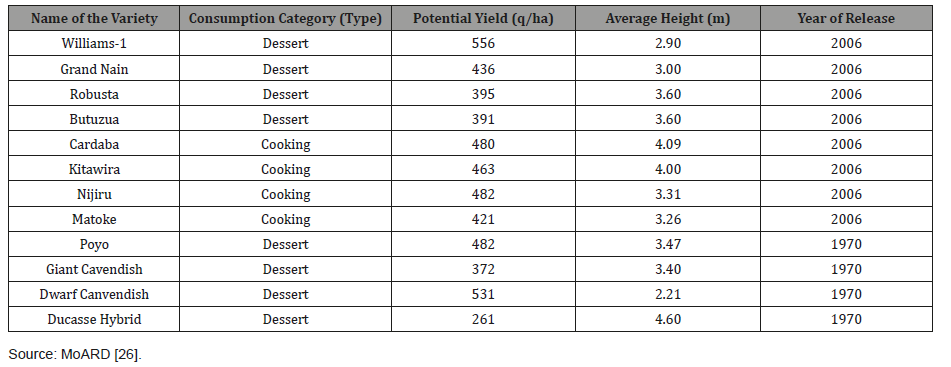
Production zones
Overall, banana is mainly produced in the southwestern part of the country in the Southern Nations, Nationalities and Peoples Regional State (SNNP) and Oromiya Regional States. The specific major banana production area in the country is Arba Minch area with about 2500 hectares of banana plantation and the second major production area are in the southwestern part of the country around Jimma, Sheka, Kaffa, and Bench Maji zones in Southern and Oromiya regional states. Banana production in Amhara, Tigray, Benishangul- Gumuz, and Gambella is mainly for domestic production under very traditional system as a garden crop. However, due to the promotion of different irrigation systems, which is linked with the production of fruits and vegetable all over the country, banana production in the stated regions including in Afar and Somali Regional States is coming into picture. The Afar and Somali Regional State do have huge potential for the production of banana due to the availability of rivers for irrigation like Awash River in Afar and Wabishebele in Somali Region.
Gamo Gofa Zone in SNNP and West Wollega zone in Oromiya are the major producing zones (Figure 1). When comparing the wereda level with zonal distribution, there is considerable variability in the allocation of land among weredas in a given zone. This is mainly due to the fact that banana in the country is mainly produced using supplementary irrigation. Even though, a given wereda is suitable for banana production, it may not produce due lack of access to irrigation.
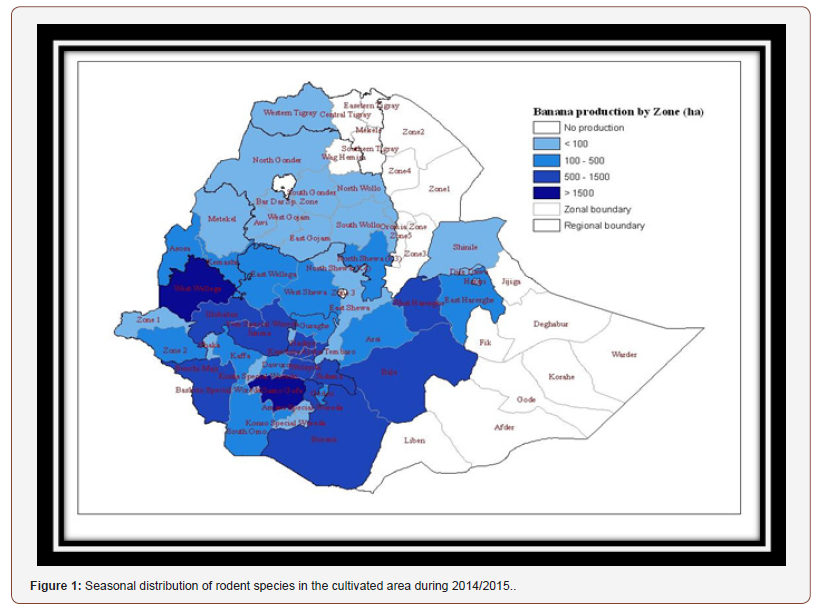
Kathirvel N [7] analyzed the economic factors limiting to banana production with the help of Garrett Ranking technique. He pointed out that credit inadequacy was the major problem (rank 1) in the production of banana. High fertilizer cost was the next important problem (rank 2). The small size of farm holdings, the lack of technical guidance was the least important problems.
Joel Mpawenimana [8] in his study analyzed the socio-economic factors influencing the production of bananas in Kanama district in Rwanda. After estimating the relationship between the output of bananas and various socio-economic factors, the findings showed that various socio-economic factors have to be reviewed in order to improve the production of bananas in the country. The results described that land, physical capital, fertilizer and price, have positive relationship with the banana output.
Several studies have identified the determinants of yield for banana production. Apart from inputs of production, other factors have influenced yield levels. Yamano, T: 2015 examined the integration of dairy and banana farms in Uganda and the effects of selected determinants on banana yield. Results of the study revealed that the amount of organic matter, plot size, tenancy, number of male household members, farm assets, land altitude, population density, and rainfall were statistically significant predictors of banana productions.
Banana Production trends
Based on the production estimates for 2002 production season about 24 thousand hectares of farmland was allocated for banana nationally with considerable variation among regions. Based on the level of banana production, SNNP Region ranks first followed by Oromiya, Amhara, and Benishangul-Gumuz. However, based on the proportion of farmers involved in banana production, Gambella region ranks first where about 31% of the farm households are involved in banana production, followed by SNNP (28%), Benishangul-Gumuz (19%), Oromiya (16%), and Afar 11%) with about 14% of farmers growing banana at national level (Table 2 & 3).
Table 2: Importance of banana (estimates from 2002).
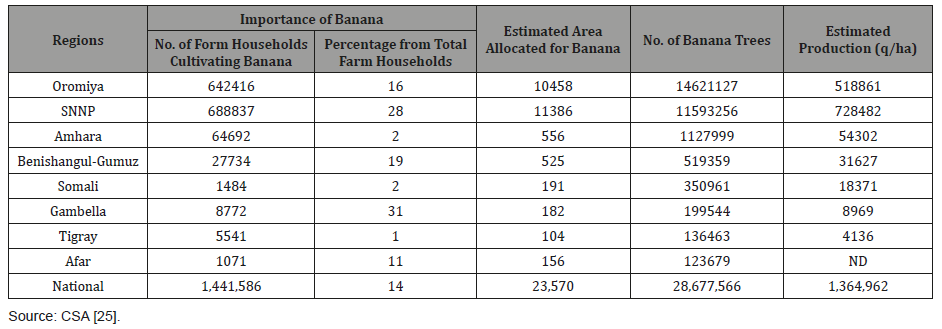
Table 3: Production level of banana (quintals).
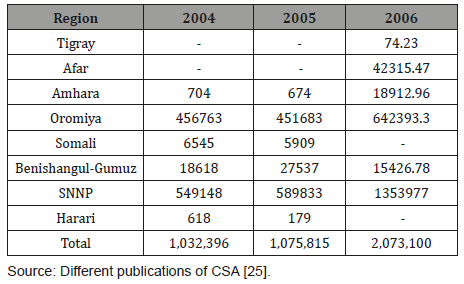
Consumption
Unlike other East African countries, banana is consumed only in the form of fresh in Ethiopia. This is mainly because the type of banana produced in the country is dessert type and there is no tradition to use it in different form. Rather, false banana, which is mainly produced in the SNNP regional state, is the major source of energy food. The traditional dishes produced from false banana are Bulla and Kocho. The expansion of the food industry in the urban areas and the increased demand for processed foods especially for children is expected to create demand for banana processing.
Banana Marketing Stages, Functions and Agents
Analyses of the supply chain of banana
The overall supply chain of banana in Ethiopia can be broadly divided into two chains, the first being the chain from the major production area to the terminal market (Atkilt Tera) and the second the chain that starts from the banana producers as garden crop to the local rural or wereda markets.
The entire supply of banana to the terminal market comes from Gamo Gofa Zone. The supply of banana from the Zone is from three sources: the state farm, farmers’ fruit and vegetable marketing union and individual farmers. The land allocated by the state farm is about 285 ha, by members of marketing cooperatives is about 500 ha and more than 2000 ha of land by individual farmers. This shows that individual farmers still dominate in the production of banana.
Small-scale producers: Small-scale banana producers are found almost in all parts of the country where banana can be produced. In general, small-scale farmers can be categorized into two groups. The first category of farmers is those who produce banana as one of their major production activities and the second category are those who produce banana as garden crop mainly for home consumption. They usually produce in small amount mainly for domestic consumption and if surplus for sale in local markets. Purchasers usually are local consumers and local retailers. Such producers transport banana using locally made bamboo baskets either at the back of women or at using pack animal. Due to the recent government intervention in promoting group marketing through marketing cooperatives, there are farmers who are members of such cooperatives in the major banana production areas. However, dominant part of the marketed surplus (62%) comes from farmers who are not members of marketing cooperatives.
State farms: The role of state farms in the country has been diminishing since 1990s following the privatization process. There were two state farms producing banana, however, due to disease one of the farms had abandoned banana production.
Upper awash agro-industry enterprise: This is a state owned enterprise with three major farms and Awara Melka state farm is the one with banana plantation. However, recently the plantation is abandoned due to the deterioration of fruit size and quality because of a severe nematode infestation and the banana plantation is replaced by sugar cane plantation.
North omo agricultural development enterprise: This is also a state owned enterprise with two farms i.e. Arba Minch state farm and Sille State Farm, which are the major supplier of banana to ETFRUIT. Overall land size allocated to banana in both farms at present is 285 ha. There is a plan to increase this to 400 ha. The supply of banana is more or less stable over a year with some fluctuation (Figure 2 & 3).
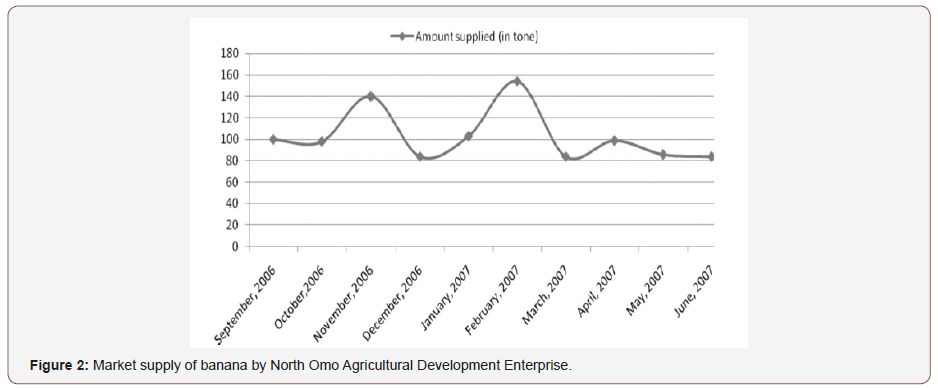
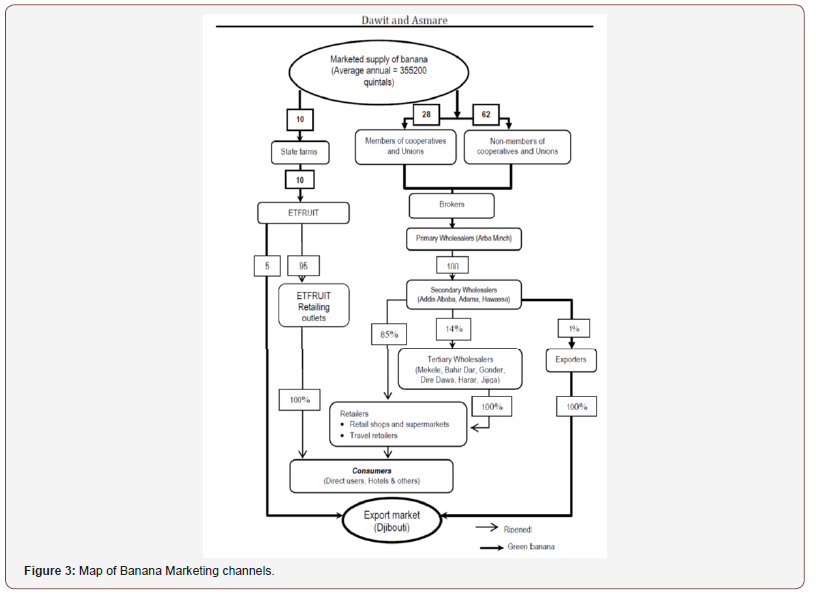
Market Structure, Conduct and Performance of Banana in Ethiopia
Market structure of banana
Market structure analysis covers other market actors outside of farming households such as importers/ exporters, wholesalers, retailers, assembler/ collectors, transporters and laborers [9].
Market concentration: According to Tomek, et al. [10], concentration ratio refers to the number, and relative size of buyers in the market. The structure performance hypothesis states that the degree of market concentration is inversely related to the degree of competition [11]. The concentration ratio is given as:

Where, C = concentration ratio,
Si = the percentage market share of the ith firm,
r = the number of relatively larger firms for which the ratio is going to be calculated.
Concentration ratio of 50% or more is an indication of a strongly oligopolistic industry, 33-50% a weak oligopoly and less than that a competitive industry [12].
Market concentration measure: According to Getahun Kassa, et al. [13], the concentration ratio of the biggest four firms were considered to determine the structure of the market. 40 traders in each specific fruit type were interviewed to understand the structure in the market (Table 4).
Table 4: Type of banana varieties released.

The table is the results of the research done by [13], so the CR4 for banana was 86.76 percent which indicated that the market structure for banana was strong oligopoly.
According to Severova, et al. [14], oligopoly can be defined as a market model of the imperfect competition type, assuming the existence of only a few companies in a sector or industry, from which at least some have a significant market share and can therefore affect the production prices in the market. Therefore, a strong oligopoly market structure for banana implies that the concentration of market power on few big wholesalers.
Market conduct: Meijer [15] said that, “conduct is pattern of behavior which enterprises follow in adopting or adjusting to the market in which they sell or buy”, in other words the strategies of the actors operating in the market.
Market conduct investigates the behaviors and rules that regulate the relationships between actors or how they engage with one another [9].
According to Getahun Kassa, et al. [13] Market conduct indicated components like level of competition, the accepted standards in the market, transparency of transactions and terms of payment.
a. Price Setting mechanisms: Fruit products (banana) are easily perishable by their very nature. Once the status of the fruit products reached maturity level, the producer’s power to influence price is insignificant. In the study area, due to the existence of too many producers and few numbers of traders, producers were price takers.
Ayelech [16] reported that farmers do not negotiate on price to sell their produce; indicating this large number of producers are price takers.
b. Standard setting in the market: The existence of few numbers of traders in the market also gave a significant power for traders to set the standards of the fruit products. Most of the time, a good quality banana fruit product is determined by visual observations. After harvesting, the trader can reject the offer by the producer if the trader believed that it is a poor quality product; or low price will be offered to the producer for poor product quality. The lack of additional premium for good quality fruit products discouraged farmers from performing activities which can enhance product quality. Furthermore, constant price offered for fruit products irrespective of quality made farmers subservient to the needs of traders and agents [13].
c. Sources and transparency of information: Clear market information is highly crucial to create transparency and efficiency in the banana fruit markets. Imperfect information is one of the causes for imperfect market. There is no formal source of information for producers regarding pricing and overall market situation in the country. Most producers relied on informal sources of information obtained from neighbors, brokers and traders. Regarding information transparency, there is no perfect exchange of information between producers and traders about product price in terminal markets. Therefore, in the absence of timely and reliable market information, market fails to bring economic efficiency [13].
Nega, et al. [17] reported that the majority of fruit producers lack adequate, timely and reliable market information in the study area.
d. Terms of trade: There was no formalized or regulated system in which effective exchange could take place between producers and traders. Regarding terms of payment, there was irregularity. Most of the time an exchange was being made on cash basis, but there were some room for post payment. More than 90 percent of producers practiced cash in hand system. On the contrary, all local traders stated that they received post payment. This implies that a deferral payment method was practiced between local traders and big city traders. The lack of formal and regulated trading system between actors in the chain typifies traditional marketing system where exchange took place based on trust and good social relationship. Since there is no legally binding agreement between actors in the chain, experiencing defraud is very common while entering into a new market [13].
Adugna [18] & Nega, et al. [17] found that large proportion of the fruit producers practiced cash in hand system and take the price as soon as they sell the fruits.
e. Market performance (Marketing margin) of banana: Market performance is concerned with the benefits an industry generates for its different stakeholders [19]. Measures of market performance reveal whether there is market power in an industry [20]. To evaluate market performance marketing margins analysis and sales volumes were analyzed. The total marketing margin is given by the formula shown below:

Where TGMM – Total gross marketing margin
Computing the total gross marketing margin (TGMM) is always related to the final price paid by the end buyer and is expressed as a percentage [21]. Wider marketing margin indicates high price to consumers and low price to producers and it is an indicator of the existence of imperfect markets [22]. The producers’ margin (which is the portion of the price paid by the consumer that goes to the producer) is calculated as:
GMMp = 1 - TGMM
Where: GMMp is producers’ share in consumer price.
The above equation tells us that a higher marketing margin diminishes producers’ share and vice versa. It also provides an indication of welfare distribution among production and marketing agents.
Market performance refers to the impact of structure and conduct as measured in terms variables such as prices, marketing margins, and volume of output.
f. Performance of banana market chain: The performance of banana market chain was calculated by taking common market catchment for all traders. This happened because of its accessibility to all local traders as compared to other market catchment.
According to Getahun Kassa, et al. [13] in bench Maji Zone south west Ethiopia, in terms of TGMM, total gross marketing margin in channel II and channel IV were 83.33 percent for each respective channel. TGMM in channel III was 85.33 percent. Channel I accounted for 60 percent of TGMM. According to Cramer, et al. [22], wider marketing margins in all channels were good indicators of the existence of imperfect markets for banana.
In the final price for the different channels of the banana marketing system, producers captured 16.67 percent of the final price in channel II linking producers and wholesalers through brokers; followed by 16.67 percent in channel IV linking producers directly to wholesalers.14.67 percent of the final price was captured in channel III where producers and wholesalers linked through collectors. The highest producers’ share was 40 percent in channel I where banana flowed from producers to local consumers through farmer traders. High TGMM diminished the share of producer’s in final price.
In terms of carrying large volumes of banana, 89.48 percent of sales volumes accounted for channel III, followed by 8.21 percent for channel IV, 2.31 percent for channel II, and the remaining 0.001% of sales volumes accounted for farmer traders. This implies that channel III is more efficient in terms of distributing large volumes of sales. The result revealed that wholesalers preferred to be linked with producers through Collectors’ cooperatives (channel III).
Collectors’ cooperatives’ knowledge of the locality made this channel highly preferable for wholesalers in providing information about marketable products which in turn saved wholesalers’ time (Table 5).
Table 5: Performance of the banana market chain.
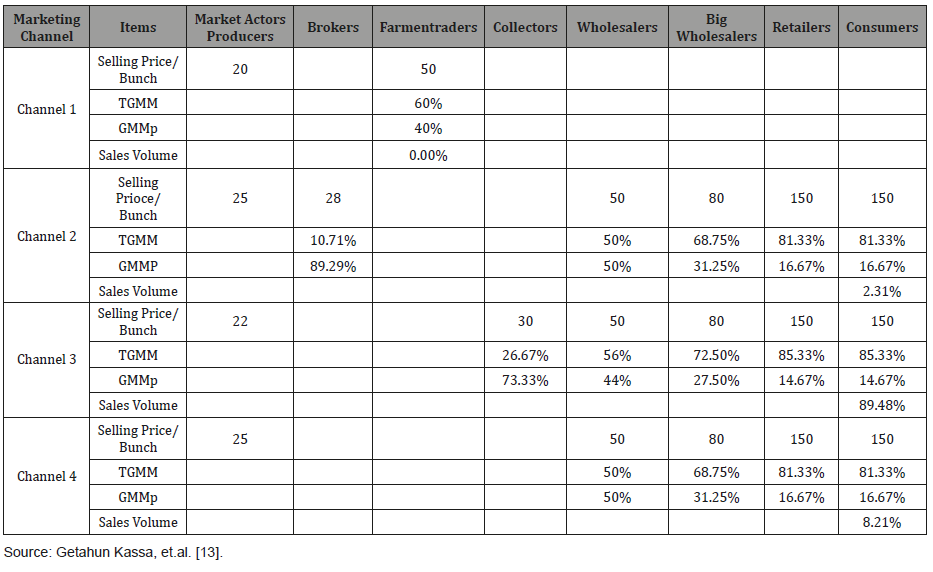
Challenges of fruits (banana) marketing
a. Seasonality: Seasonality is another factor affecting banana marketing. As seasonal price fluctuation is the major problem in banana’s marketing [13]. During peak supply period, price declined. In peak seasons, the perishability of the products does not give enough time for producers to look for alternative market opportunities. Thus, producers accept low price offered in peak seasons to avoid massive loss of profits.
Getahun Kassa, et al. [13] demonstrated that price declined by more than 15 percent in peak seasons. This implies that when there is excess supply of fruits, price declines. Therefore, seasonal price fluctuation is common implying that supply and price moves in opposite direction.
b. Few numbers of big traders: The existence of many producers but very few big traders which in turn lead to large volumes of outputs produce must be absorbed by high demand in big cities. Research indicates that limited access to market is among the challenges of banana marketing in the country. The participation of big traders in the fruits industries is highly important in bringing better opportunity for producers. However, the existence of few big traders in the fruits industries limited producers’ access to more efficient market channel [13].
c. Lack of organized market center: Getahun Kassa, et al. [13] revealed that lack of organized market center is one of the basic problems for the existence of imperfect competition. Getting better incentives in terminal markets depend on the quality of the produce to be offered in those markets. However, due to absence of market center in which good product quality is inspected and standardized, producers and traders failed to receive their fair share from the market in big cities.
d. Brokers’ interference: The main role of brokers/ agents in the fruits (banana) markets is providing information about price and output both for producers and traders. As a result, they are considered as the most reliable partners for traders in making deals with producers. Brokers created collusion in the fruit’s markets in terms of geographic dispersion to avoid unnecessary competition. This collusion helped them to monopolize a certain geographic area. So, without brokers, it is hardly possible to create direct link between producers and traders.
Conclusion
We have tried to conclude our review: Dessert banana is the major fruit crop that is most widely grown and consumed in Ethiopia [23-25]. It is cultivated in several parts where the growing conditions are favorable. Especially in the south and southwestern parts of the country, it is of great socioeconomic importance contributing significantly to the overall wellbeing of the rural communities including food security, income generation and job creation. Banana market channel linked producers to local consumers through farmer traders. The structure of banana market at each market level depends on the level of competition existing in the banana market, the market concentration ratio was used as evaluation criteria. Banana market performance is evaluated based on the level of marketing margins by taking into consideration associated marketing costs for key marketing channels.
The high the market concentration ratio indicates oligopoly market structure. The existence of few big-traders in the market gave market power for traders in deciding output price and setting product quality standard [26,27]. The TGMM indicates that the markets for banana were imperfect markets. However, the most efficient banana market channel in the area was the one that links producers to wholesalers through Collectors’ cooperatives. Collectors’ cooperatives good knowledge of the locality made this channel a preferable channel to distribute large volumes of banana products to terminal markets in big cities. However, seasonal price fluctuation, the existence of few big traders, limited access to information, lack of organized market center, and brokers’ interference mainly affected the performance of banana fruit market in the country.
Hence as we have reviewed several researches conducted by several authors are concentrated in the southwestern part of the country in the Southern Nations, Nationalities and Peoples Regional State (SNNP) and Oromia Regional States this is due to the authors select this area purposively depending on productions potential. So that it’s better if researches are conducted on other part of the country. And also, several researches are conducted on banana marketing but not on production, again its better if researcher include its production in their thesis.
Acknowledgement
None.
Conflict of Interest
No conflict of interest.
References
- El-Sherbiny AH (1987) Cyclic fluctuation in rodent population: Review of current researches. Egypt wild and not resources 19: 1-17.
- Witmer G, Campbell EW, Boyd F (1998) Rat management for endangered species protection in the U.S. Virgin Islands. Proceedings of the Vertebrate Pest Conference 18: 281-286.
- Abdel Gawad KH (2010) Rodent species composition in the present compared with past, the 5 Scientific Conferences for Agric, Assiut Univ, pp. 159-167.
- Desoky ASS (2007) Management strategies for rodents within different ecosystems. M. Sc. Thesis, Fac Agric, Assiut Univ, pp. 124.
- Desoky ASS, Baghdadi SAS, Ahmed HSK (2014) Population density and seasonal distribution of rodent species at sheep farming in El-kawther city, Sohag region, Egypt J Plant Prot and Path, Mansoura Univ 5(10): 903- 907.
- Desoky ASS, AA Sallam, WAM Radwan (2018) Population Density of the White Bellied Rat, Rattus Rattus Frugivorous in El-Kawther City, Sohag Governorate, Egypt. Current Investigations in Agriculture and Current Research 4(2).
-
Zinabu Ambisa, Bikila Tesfa, Temsgen Olani, Diriba Abdeta. Review on the Production and Marketing of Banana in Ethiopia. World J Agri & Soil Sci. 2(1): 2019. WJASS.MS.ID.000529.
-
Banana, Constraint, Marketing, Production, Supply chain of banana, State farms, Market structure, Marketing margin
-

This work is licensed under a Creative Commons Attribution-NonCommercial 4.0 International License.






